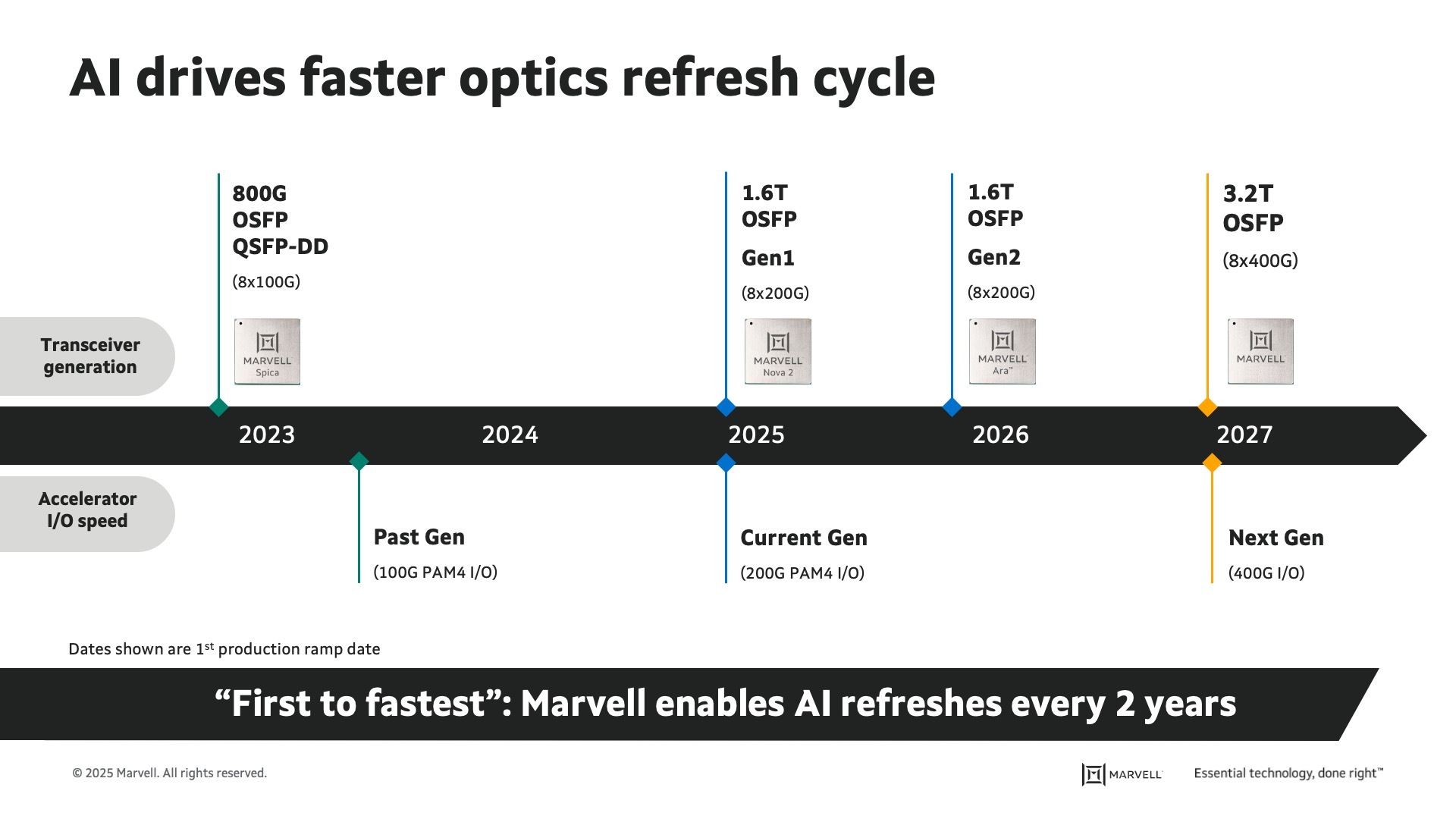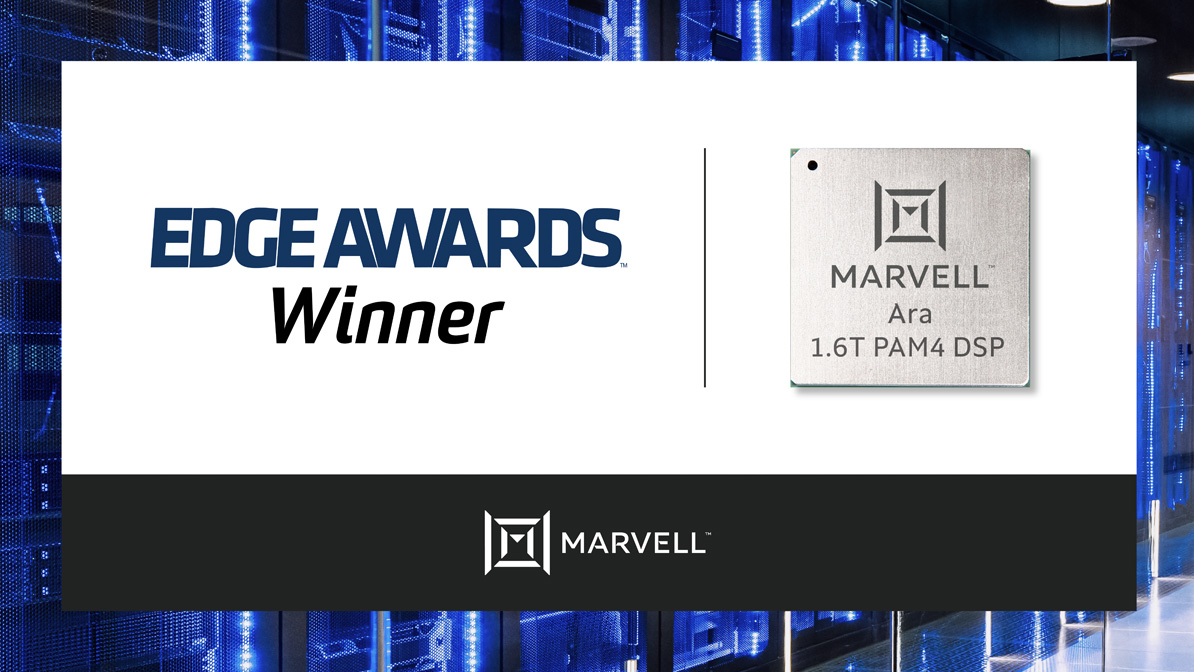

The explosion of AI, cloud and hyperscale computing is driving networks to new extremes. As bandwidth needs surge beyond 800G and move toward 1.6T, optical DSPs are the foundation enabling high-throughput, low-latency, low-power and resilient optical links.
Marvell® is at the forefront of this change, delivering PAM4, coherent and coherent-lite DSPs that power AI fabrics, data center interconnects and telecom networks with unmatched performance and energy efficiency.
Marvell is transforming optical connectivity, enabling higher bandwidth data transmission across every distance regime in modern AI infrastructure.

AI workloads generate massive data flows between AI servers, network switches storage systems. Beyond distances of about 10 meters, copper interconnects can’t meet the bandwidth and reach required inside and between AI data centers.
Optical DSPs are at the heart of the pluggable optical modules that enable data transmission over fiberoptic cables. They convert electrical signals to light, correct distortion in real time, and ensure reliable, low-latency transmission from tens of meters to thousands of kilometers.
As AI data center bandwidth requirements scale from 400 Gbps to 800 Gbps to 1.6 Tbps and beyond, technologies like PAM4, coherent and coherent-lite, as well as silicon photonics, power optical modules that deliver high-bandwidth connectivity inside data centers, across data center campuses and between geographically dispersed data centers.
An optical digital signal processor (DSP) converts high-speed electrical data into optical signals and corrects errors to ensure signal integrity over distance. Optical DSPs are used in the pluggable optical modules essential for enabling high-bandwidth, low-latency and power-efficient optical links in AI, cloud and data center networks.
Optical DSPs, and the optical modules in which they’re used, transmit data over fiber in the form of light, whereas copper interconnects transmit data over copper in the form of electrical signals. As the data rate increases, the distance over which a signal can travel over copper decreases, making copper interconnects only suitable for short-reach connections. Optical modules based on optical DSPs, meanwhile, are used for distances of tens of meters to thousands of kilometers.
Marvell optical leadership is grounded in a long history of system design, silicon photonics and digital signal processing expertise highlighted by the addition of Inphi Corporation (acquired April 2021). The Inphi acquisition brought world-class optical DSP IP and engineering talent into Marvell; the combined capabilities enabled Marvell to accelerate the development of both PAM4 and coherent DSP technologies for hyperscale and carrier markets.
Recent product announcements illustrate the leading-edge nature of Marvell optical DSP portfolio: the 3nm Marvell® Ara 1.6 Tbps PAM4 platform, the Marvell® Aquila 1.6 Tbps O-band optimized coherent-lite platform, the award-winning Marvell® COLORZ® 800 DCI module and a broad range of DSP products and chipset components for pluggable and linear optics. These publicly announced product milestones underscore the Marvell strategy of being “first to fastest” with integrated, energy-efficient optical interconnect solutions delivered at scale.

| Product Type | Products | Key Specifications | Primary Use Case |
|---|---|---|---|
| PAM DSPs | Ara, Nova, Spica, Perseus, Porrima, Alcor, Polaris, Atlas | 50G–1.6T PAM4 DSP portfolio; 3nm–16nm; integrated TIA/driver; low power; FEC and diagnostics | AI data centers, cloud interconnects, 800G–1.6T optical modules, short-reach and long-reach pluggables |
| Coherent DSPs | Orion, Canopus, Deneb | 400G–800G coherent DSPs; 5nm / 7nm; probabilistic shaping; advanced FEC; multi-rate; low power | DCI, metro, long-haul optical transport, IP-over-DWDM, 5G backhaul |
| Coherent-lite DSPs | Aquila | O-band optimized; 400G 16-QAM; low-power; 2–20 km reach; integrated drivers | Intra-campus optical links; 800G/1.6T campus modules bridging PAM4 and coherent |
| Optical / DCI Modules | COLORZ 800, COLORZ 400 COLORZ | Pluggable coherent modules embedding Orion DSP; 400G–800G; long-reach support |
Metro / regional / data center interconnect (DCI) |
| Linear Drivers | IN4326DZ, IN6426DZ, IN10026DZ, IN12826FC, IN2814DV etc. | High-linearity analog drivers; 100G–1.6T; wide bandwidth; low power | Drives optical modulators (EML, MZM) inside PAM4 and coherent modules |
| TIAs | 200G TIA family, Flip-chip TIAs | High sensitivity and low noise; 200G/lane; hybrid integration ready | Optical receivers / pluggable modules; analog front end
|
| PCIe Retimers | Alaska P Gen 6 Retimer Family | PCIe Gen6 / CXL PAM4 retimers; extends signal reach; maintains integrity | Extending PCIe over cable / optical links in servers and AI compute fabrics
|
The cutting-edge work Marvell has done in optical DSPs, next-generation interconnects and pluggable optics continues to gain industry validation. Below are some of the key honors that underscore how Marvell is a leader in connectivity innovation:
Leading EDGE Award (2025): The Marvell Ara 1.6T PAM4 optical DSP (built using 3nm process technology) was selected as the overall Leading EDGE winner, recognizing design innovation in next-generation optical interconnects.
Lightwave Innovation Awards (2021-2025): For five consecutive years, multiple Marvell optical DSP and connectivity products or product lines received honors, showcasing the company’s leadership across the optical ecosystem. In 2025, five different Marvell products or product lines were recognized with awards.
Electronic Products 2024 Products of the Year: The 5nm Marvell® Spica Gen2-T optical DSP was selected for its low-power 800G operation.
Most Innovative Pluggable Transceiver / Co-packaged Module: At ECOC 2024, the COLORZ 800 was awarded for innovation in pluggable optics integration.
These accolades reaffirm the strength and ability of Marvell to enable high-speed, energy-efficient optical connectivity and contribute to its growing authority and influence in AI infrastructure.

| Application | DESCRIPTION | Products |
|---|---|---|
| Campus | Connects buildings in large data center campuses over distances of 2–20km |
Marvell Aquila coherent-lite DSP platform |
Frontend network |
Connects AI servers to the rest of the data center over distances of up to 500m |
Marvell Ara 3nm 1.6T PAM4 DSP platform |
Backend network |
Connects AI servers within a cluster |
Marvell Ara 3nm 1.6T PAM4 DSP platform |
Scale-up network |
Connects AI servers within an AI cluster |
Low-power TIA and laser driver chipset for linear-drive pluggable optics (LPO) |

The Marvell optical vision is focused on:
Marvell continues to push the boundaries of optical performance, ensuring that every bit in the AI era moves faster and greener.
DSP chips convert electrical data into optical signals, correct distortions, and optimize transmission quality—enabling faster, low-error data transfer across fiber networks.
The PAM4 modulation used in PAM4 DSPs is optimized for optical interconnects inside the data center for distances of up to about 500 meters. Coherent technology, which uses more complex QAM modulation, is used for between-data-center connections that can exceed 1,000km. Data center interconnect (DCI) is the term used to describe these types of long-distance connections between data centers.
Coherent-lite DSP technology borrows attributes from both coherent and PAM4 DSP technologies. Modules based on coherent-lite DSPs have the operational attributes of PAM4 DSPs but with greater reach, making them power- and performance-optimized for 2–20km campus connections.
Marvell uses process-node leadership, architectural optimization, and advanced IP to ensure its optical DSPs are efficient and provide a competitive advantage.
Analysts consistently recognize Marvell among the global leaders in PAM4 and coherent optical DSP innovation.
Optical DSPs ensure high-bandwidth, low-latency connections between compute racks, rows and data centers, which is critical for AI model training and inference.
Marvell is currently working on 1.6T+ products, process node advances, silicon photonics, and new technologies.
We believe better partnerships help to build better technologies. Let’s connect and see what we can design together!
We will be in touch with you soon!
Copyright © 2025 Marvell, All rights reserved.